This is an incredible gluten-free pie crust recipe that is flaky, buttery, and easy to roll without cracking or falling apart. It is my go-to for both sweet and savory pies, and readers consistently say it is the best they have tried. Whether you are baking your first pie or you’re a seasoned pro, this crust is a game-changer.
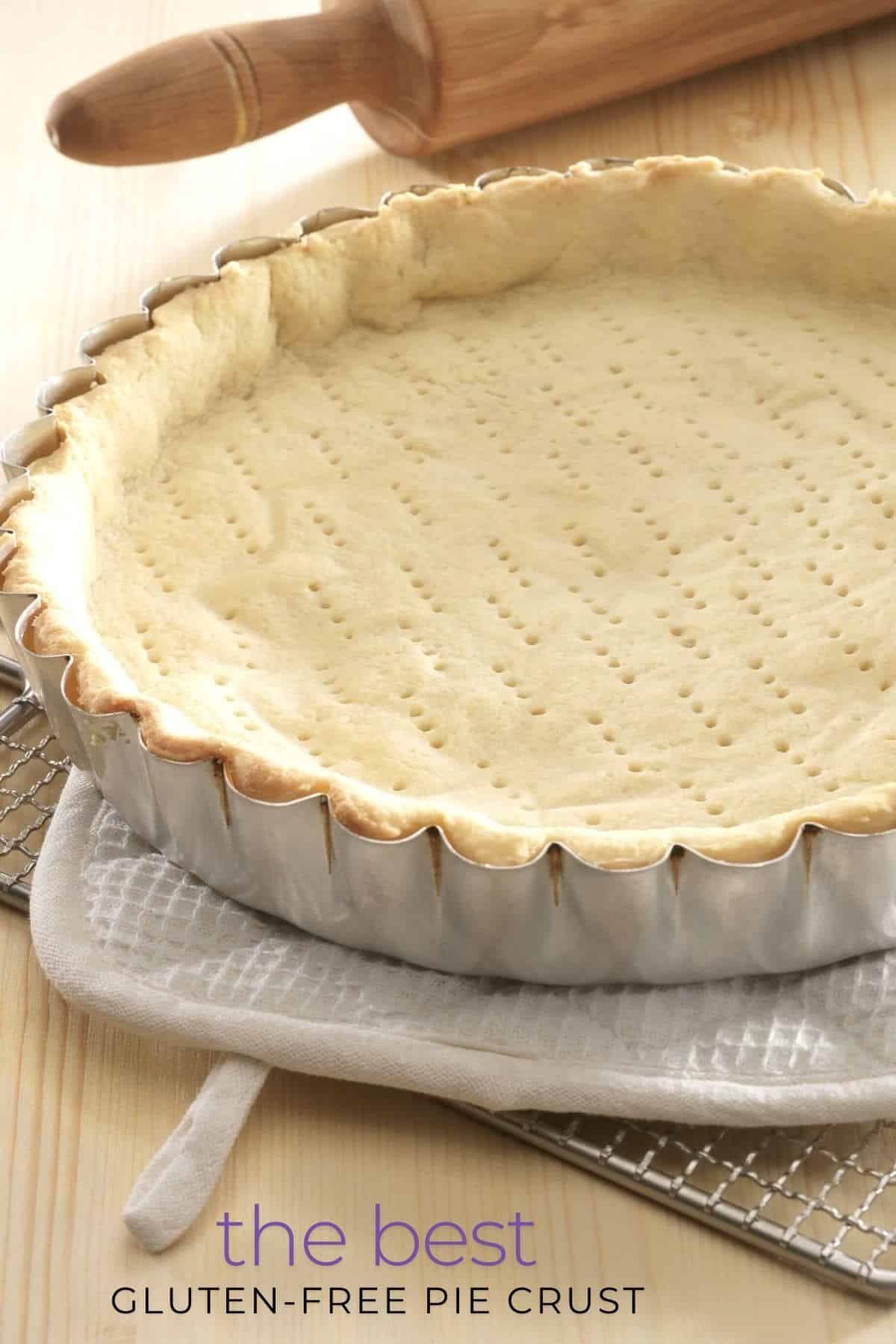
When I first started baking gluten-free, pie crust was one of the most challenging things to get right. I wanted a crust that was flaky, easy to work with, and did not taste like it was missing something. However, as many of you know, gluten-free baking can be…frustrating.
I tested batch after batch, finding some were too dry and others turned tough instead of tender. I tried different flour blends, experimented with fat ratios, and adjusted the chill time numerous times. There were definitely moments I questioned my sanity.
You only need a few simple ingredients, and I have included step-by-step photos, substitution tips, and ways to use this pie crust. If you’re tired of pie crusts that crumble, are tough to bite into, or taste bland, my recipe is a must-try.
If you love pie, check out all of my delicious gluten-free pie recipes! You may also love these Gluten-Free Apple Turnovers. If you love using sourdough discard, I highly recommend trying this Gluten-Free Sourdough Pie Crust recipe.
This post may contain affiliate links. Please read our Disclosure Policy.
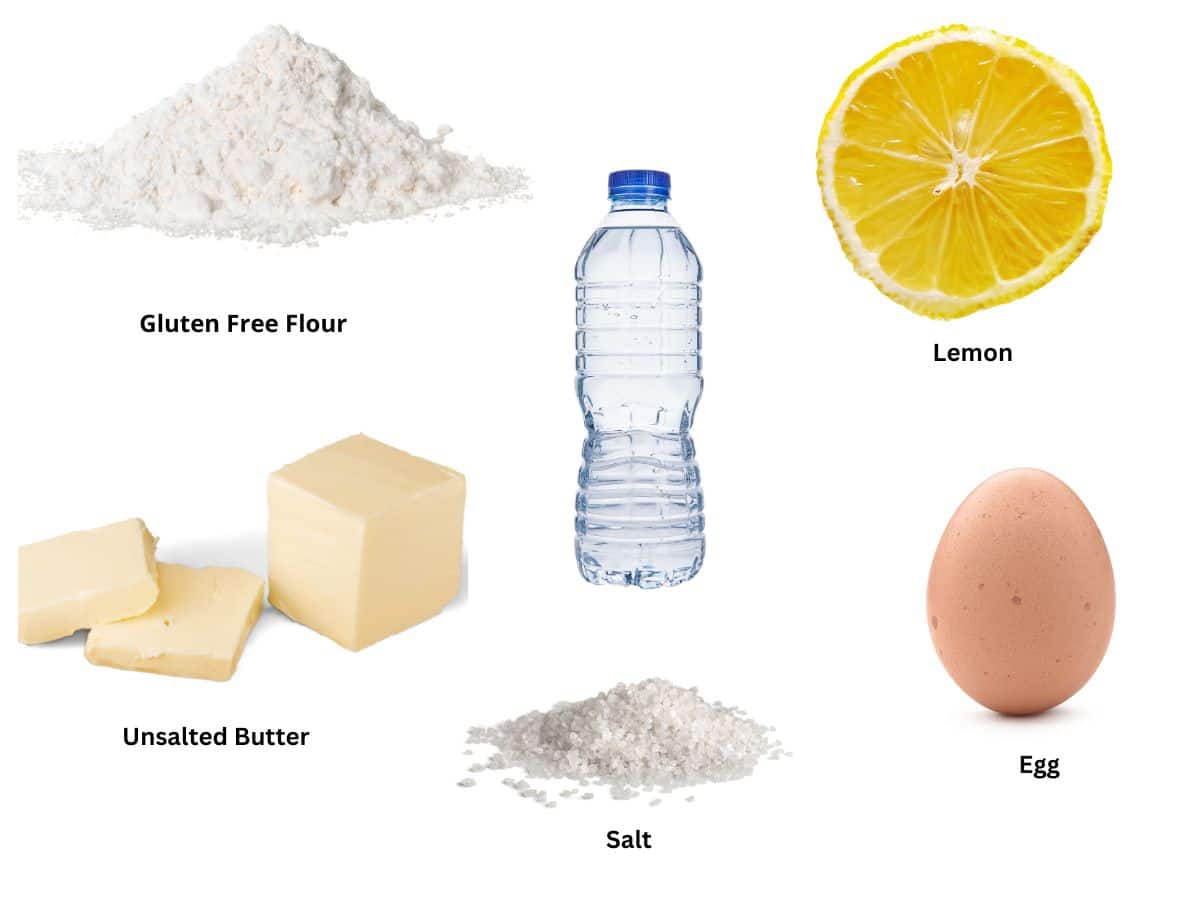
Ingredient Notes:
Note: This pie crust recipe makes a single-crust pie. If you plan to have a top crust, you will need to double this recipe for a double-crust pie. For the full list of ingredients and amounts, please go to the recipe card below.
Flour Blends Tested:
- My favorite blend is Cup4Cup for its extra flakiness. (Note: Cup4Cup recently updated its formula, which may behave a bit differently. I have not retested this crust recipe with the new version.)
- I also tested this recipe with King Arthur Measure for Measure, Bob’s Red Mill 1:1, and Pillsbury Gluten-Free Flour.
- Try my homemade gluten-free flour blends. This gluten-free pie crust recipe is delicious with my Gluten-Free All Purpose Flour Blend or my Gluten-Free Pastry Flour Blend.
Pro Tip: Every gluten-free flour blend has a different starch-to-grain ratio. Depending on the blend, your dough may need slight adjustments. I recommend adding more liquid if the dough feels dry or more flour if it is sticky. Make adjustments one tablespoon at a time. Read Why Gluten-Free Flour Blends Vary to learn more.
The Rest of the Pie Crust Ingredients:
- Xanthan Gum: If your blend does not contain xanthan or guar gum, add 3/4 teaspoon to help the crust hold together and roll without crumbling. Read Why Binders are so Important in Gluten-Free Baking to learn more.
- Cold, unsalted butter. For a dairy-free version, substitute a firm vegan butter, such as Earth Balance.
- Large Egg. This homemade gluten-free pie crust recipe uses one egg, which helps give it a little more binding and a soft texture. See below for the Egg-Free version.
- Ice-cold water. Helps keep the butter firm and creates flaky layers. I strain out the ice before measuring.
- Lemon Juice. Adds to the flavor and helps with flakiness.
Reader-Tested Variations:
- Dairy-free tested – Multiple readers had success using Earth Balance plant-based butter.
- Egg-free – “Use 3 tablespoons of whipped aquafaba, and said the crust turned out great.” Shelly
- Lard instead of butter – “Works great!” Alicia P.
- No pastry cutter? “A fork worked perfectly.” Lucy
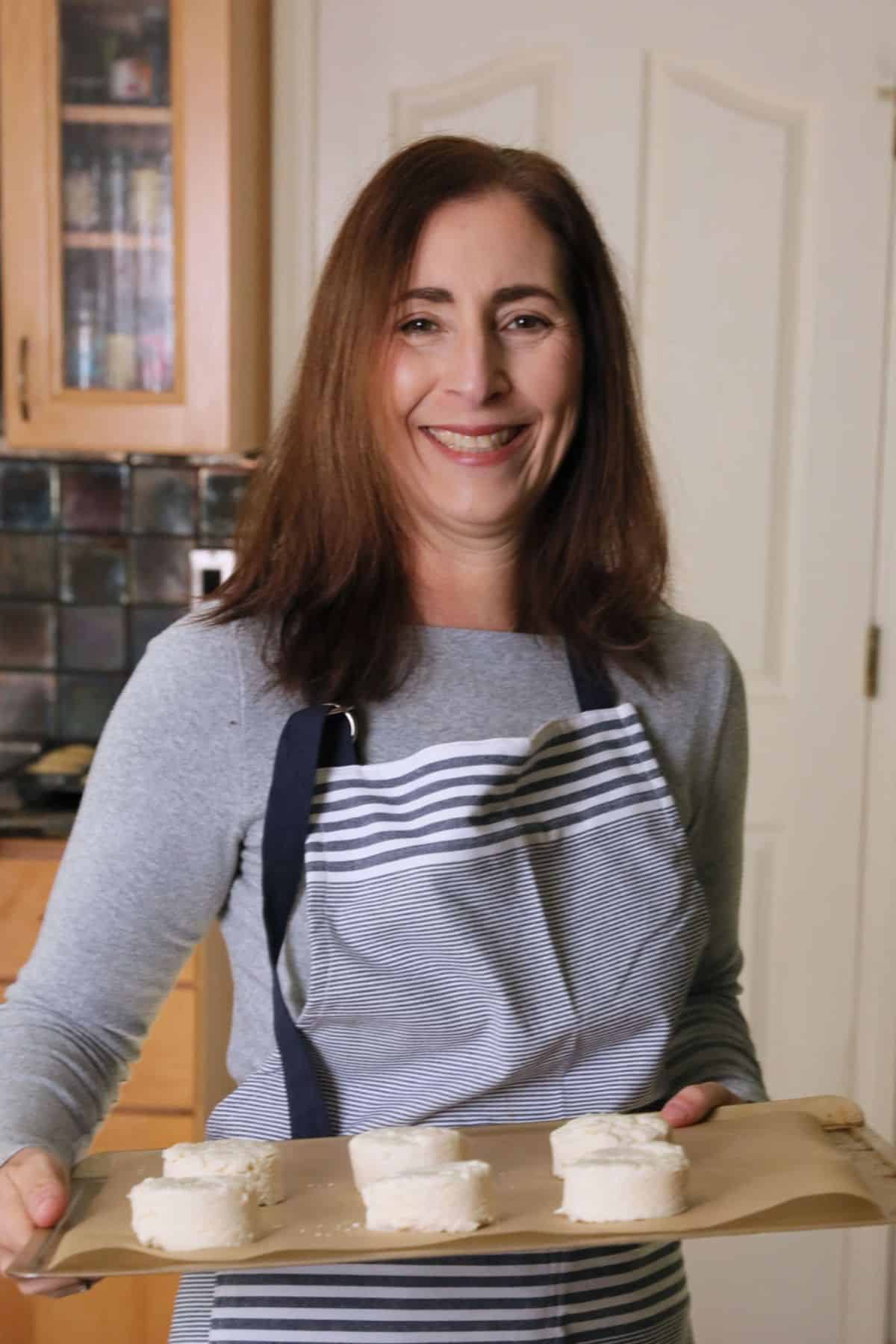
A Note From My Kitchen
This pie crust recipe is a labor of love. I spent years testing and perfecting this recipe. When we originally went gluten-free almost 15 years ago, there was no such thing as a gluten-free flour blend. Today, things are much easier.
I tested five different flour blends in this pie crust recipe. There were two clear winners when it came to flakiness. Cup4Cup and my gluten-free pastry flour (linked above). All of the flour blends yielded a beautiful flaky crust; my two favorites were just a little bit flakier.
My rule of thumb for using different flour blends is to make moisture adjustments to the dough as needed. If the crust dough seems too wet, add more flour, and if the dough seems too dry, add more water. Make these adjustments 1 tablespoon at a time to better control the level of moisture.
How to Make a Gluten-Free Pie Crust (Step-By-Step ):
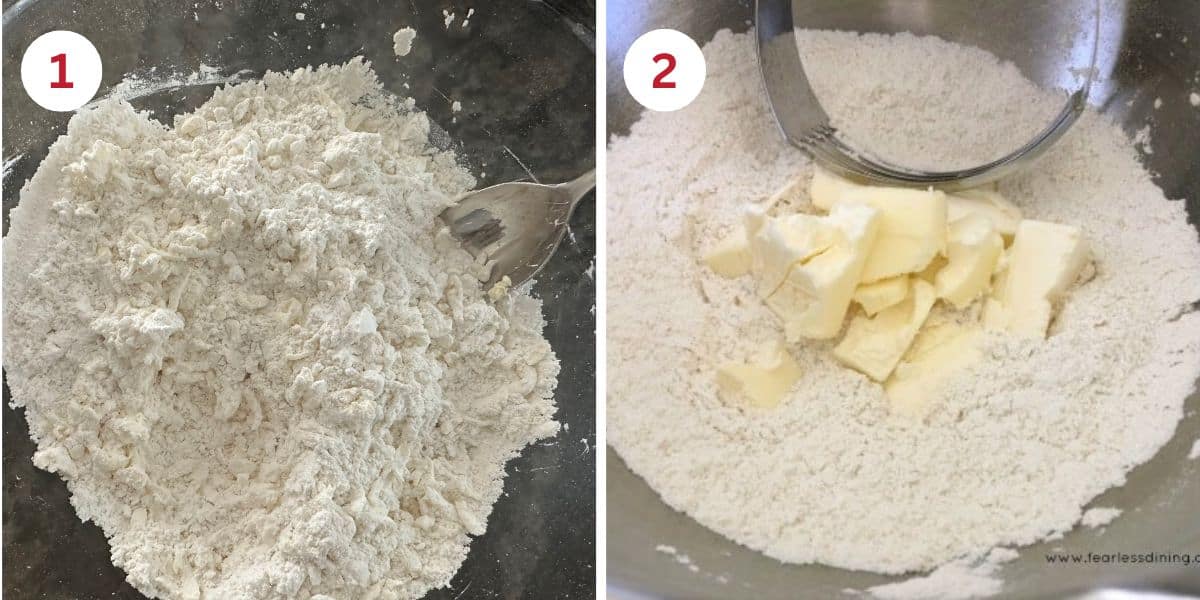
If you are making a top and bottom pie crust, be sure to double this pie crust recipe.
Step 1: Combine the gluten-free flour, binder (if needed), and salt in a large bowl. Whisk to blend.
Step 2: Cut cold butter into small cubes and add to the flour. Use a pastry blender or fork to blend until the mixture resembles coarse crumbs with pea-sized butter chunks. These butter pieces are key to a flaky texture!
👀 Sandi Says: If you don’t have a pastry blender, freeze the butter and use a cheese grater to shred the butter into the dry ingredients.
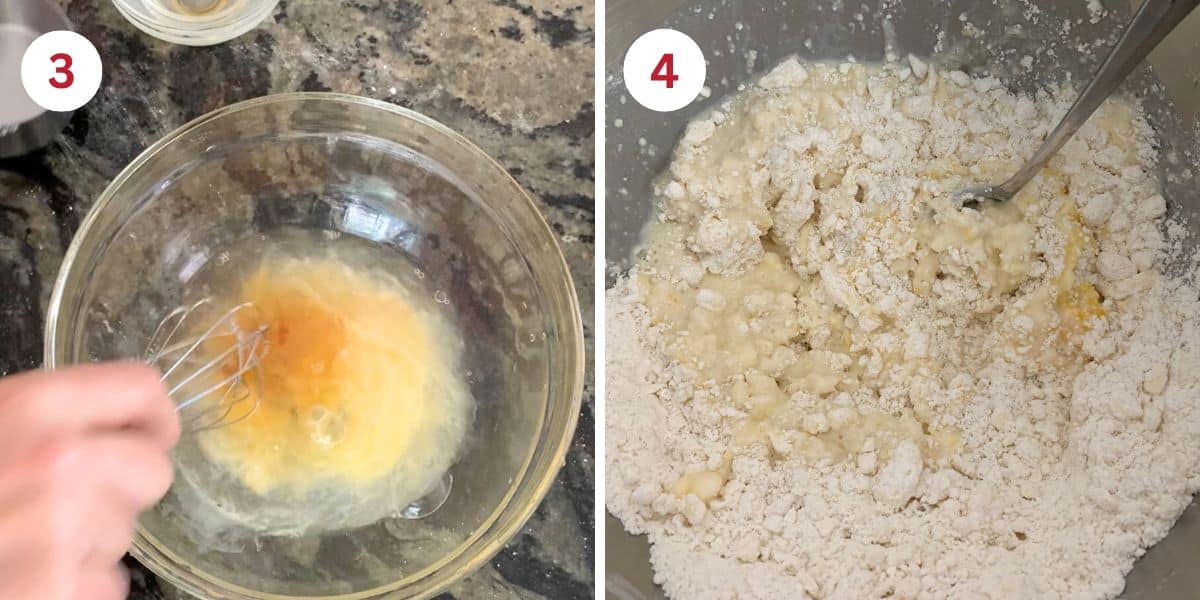
Step 3: Add the egg, cold water, and lemon juice to a small mixing bowl and whisk.
Step 4: The dough should be firm but not sticky. Add more flour or water as needed. Wrap the pie dough in plastic wrap and chill it in the refrigerator for 15 minutes, allowing the butter to cool.
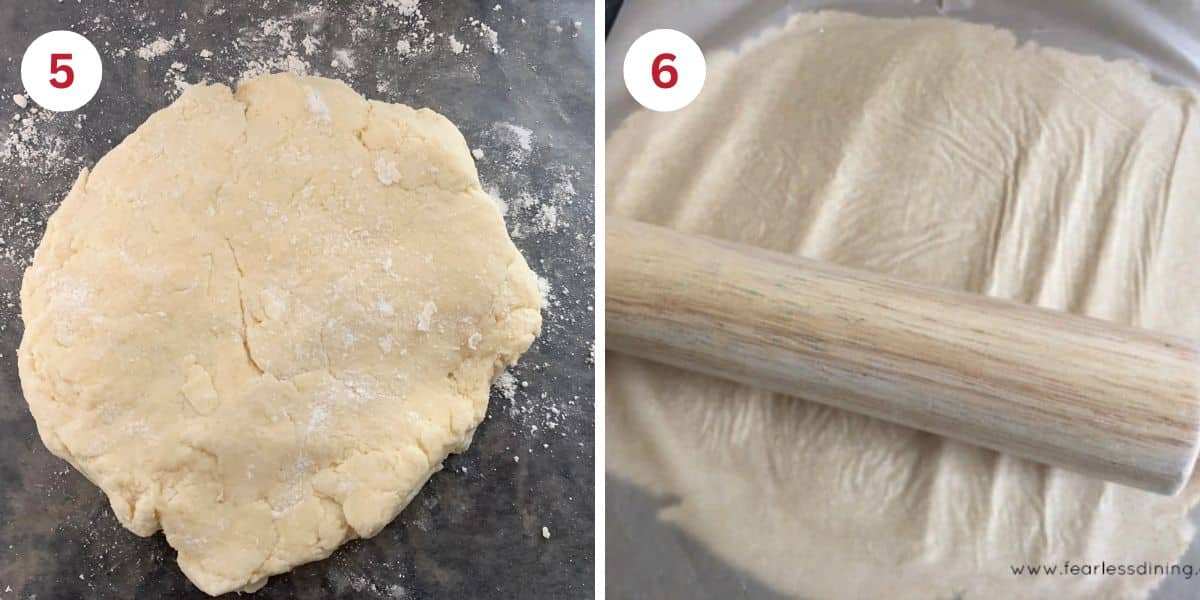
Step 5: Remove the pie dough from the fridge. Prepare your work surface by dusting a clean surface with flour or using a silicone mat. Shape the pie dough into a circle and add a second sheet of wax paper.
👀 Sandi Says: If your dough is sticky, dust the silicone mat and the top of the dough with extra flour.
Step 6: Use a rolling pin to roll the dough into a circle slightly larger than your pie pan. I like to make my dough 1/4-1/3 inch thick.
Step 7: Spray a 9-inch pie pan with gluten-free baking spray to prevent sticking. Note: PAM Baking Spray is NOT gluten-free!
Email This Recipe To Me!
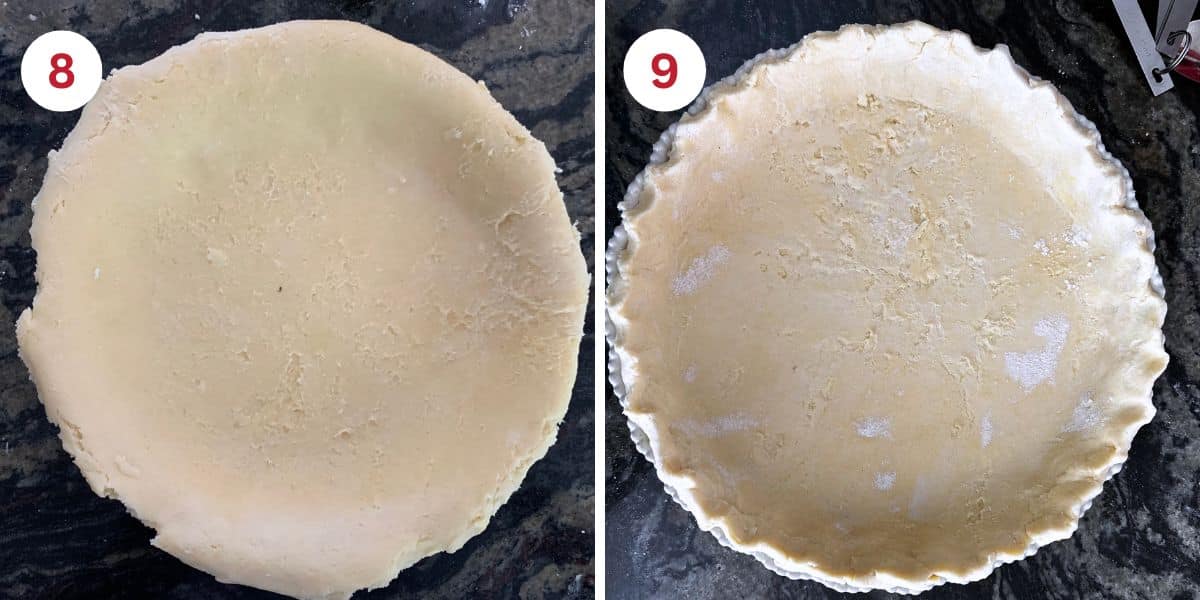
Step 8: Remove the top layer of paper and gently flip the dough into a greased 9-inch pie pan. Peel away the silicone mat from the back.
Step 9: Crimp the edges if you are not filling the crust now. To crimp the edges, hold your fingers in a V shape and place them on the outside of the crust. Use a finger to press the dough between your fingers so it crimps into the open space. Repeat this all the way around the edge of the pie crust.
Crust Instructions For No Top Crust:
- If you are not making a top crust, press the dough into the pan and crimp the edges as described above
- Add your pie filling and bake the pie at 350º F for 20-25 minutes.
- If you use a cream filling and do not need to bake the filling, poke a few holes in the bottom of the crust for air to vent.
- This will prevent air bubbles from forming at the bottom of the crust.
- Cool the crust and add the cream filling.
How to Make a Top Crust:
If you didn’t double the pie crust recipe to have enough dough for the top crust, make the top crust now.
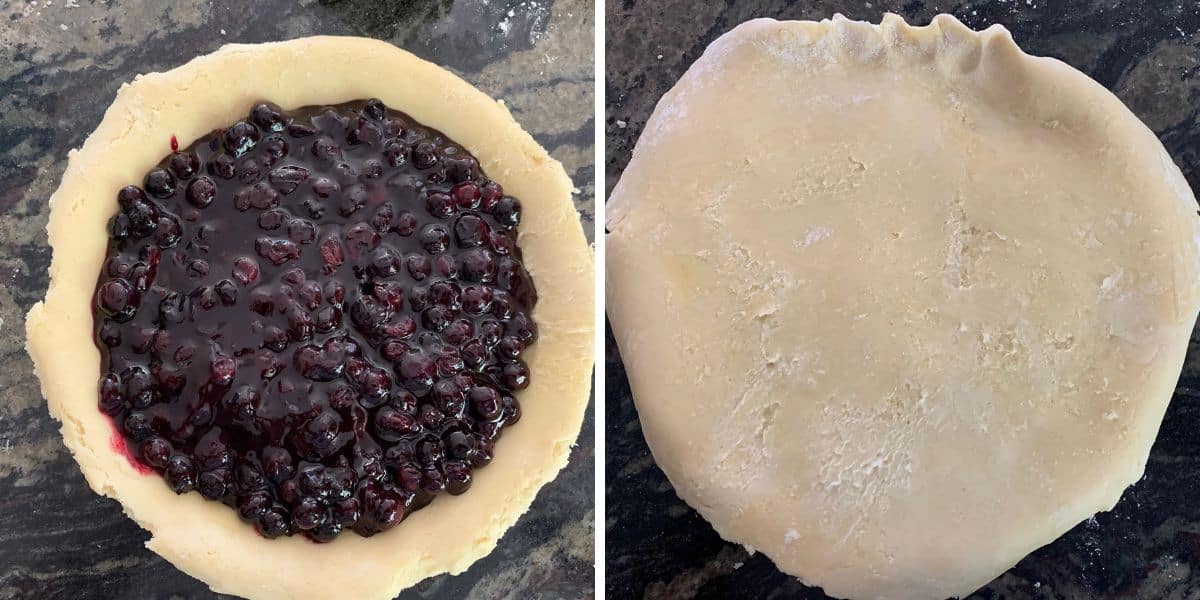
- Add your pie filling to the crust. Notice that the edges are not crimped yet.
- Roll out the top crust in the same way you would for the bottom crust.
- Place the top crust carefully over the pie filling. Center the dough so you have overlapping dough over the bottom crust.
- Follow the instructions above to crimp the top and bottom crusts together.
- Use a fork or sharp knife to cut 3-4 air holes to vent the steam while the pie bakes.
- Follow the same baking instructions. If the edges of your pie crust start to get too golden, you can make a foil tent over the crust to prevent the edges from burning.
How to Make a Lattice Top Crust:
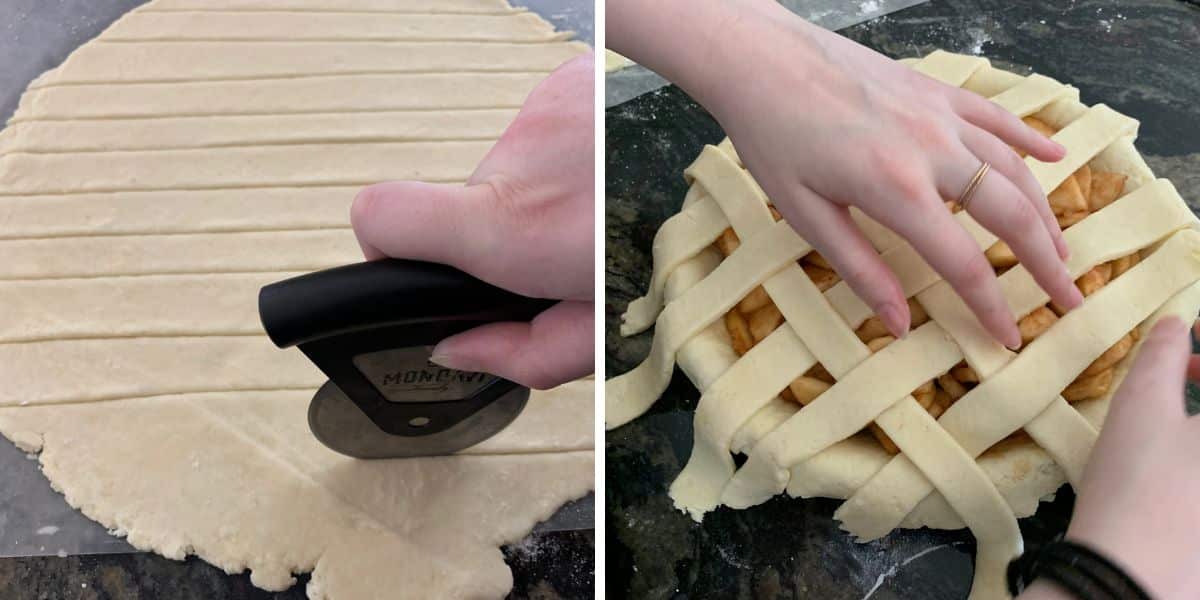
- Roll the top crust dough flat, as you would for a regular pie crust top. Use a pizza wheel or a sharp knife to cut out strips. You can make them as thick or thin as you like!
- Lay strips across the top of the pie in one direction. Take a dough strip and start at one end, weaving it in and out of the dough strips that are already across the dough. Continue with each strip until you have a woven pie crust top.
- I have a recipe with full instructions to weave the crust in my Gluten-Free Apple Pie recipe.
It is easy to give your pie crust a fancy bakery look!
- Grab your favorite cookie cutter and make a statement with the top crust! I used stars for a 4th of July pie. You can use any shape or size of cookie cutters. The complete directions are in my Gluten-Free Mixed Berry Pie post.
- You can also make mini pies in ramekin dishes, as I did with this Gluten-Free Strawberry Pies recipe.
Storage and Freezing Tips:
- Making it ahead? This pie dough will keep fresh in the refrigerator for up to 3 days.
- Store the baked pie crust in the refrigerator. It will stay fresh for up to 3 days.
- To freeze unbaked: Wrap the dough tightly in plastic wrap, then place it in a gallon-size freezer-safe bag. Squeeze out extra air.
- Freeze the baked crust in a gallon-size freezer bag if the pie isn’t too tall.
Why did the crust turn out tough?
If you have a tough crust, it is because you overmixed the butter into the flour. You need those butter chunks in the dough to create air pockets when baking, which results in flakiness.
Why is my pie crust soggy on the bottom?
If your gluten-free pie crust is soggy, there are several reasons this could happen.
- Did you use fresh or frozen fruit? Frozen fruit releases a lot of water, which can leave the pie crust with a soggy bottom.
- Did you roll the crust too thin? A Thin crust won’t hold up to a pie filling.
- If you used a liquid or custard filling, did you par-bake the crust for a few minutes first?
For more pie-making tips, see my Gluten Free Pie Troubleshooting Guide!
Frequently Asked Questions:
Heat can cause all sorts of mischief when you bake. Pinch the edges of the dough in a design. Use a fork to make steam holes in the bottom. These steam holes prevent your crust from bubbling and puffing up in a weird way.
I do not like using a food processor because it can over-grind the butter, leaving it with too small chunks that do not create those flaky layers in the crust.
I like to roll my pie crust dough, and when I think I am close to the size of the pan, I will hold the pan up to the dough circle. You want the dough to be rolled out and big enough to go up the sides and to have a little extra to pinch along the outer edges.
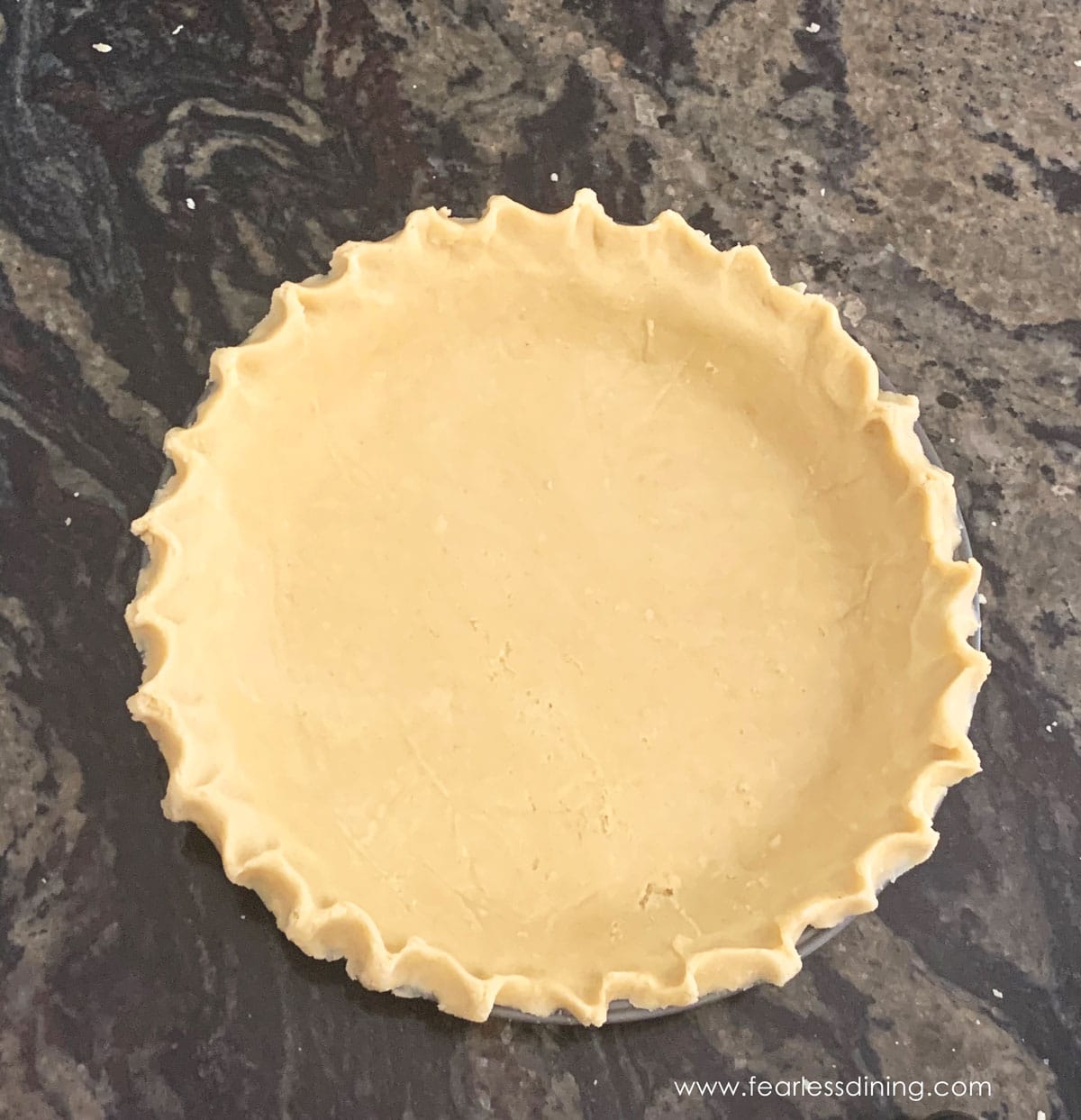
What Can You Make with This Pie Crust?
Savory Pies:
- Gluten-Free Asparagus Goat Cheese Tart recipe. You can also use this flaky pie crust for quiche recipes!
- You can use this crust to make my popular Gluten-Free Chicken Pot Pie recipe.
- Quiche is also a great way to use pie crust. For quiche, it is nice because you don’t need a top crust! My easy Gluten-Free Quiche recipe can be customized with all of your favorite mix-ins.
Sweet Pies:
- You can use this single pie crust to make delicious galettes like this Gluten-Free Plum Galette.
- If you love pecans, you must try this homemade Gluten-Free Pecan Pie recipe. It is amazing with this crust!
- You can also use this crust to make this Gluten Free Hatch Chile Apple Pie.
- This homemade Gluten-Free Blueberry Pie is a bakery-quality pie you will love!
- We love this Gluten-Free Pumpkin Pie over the fall holidays.
- This Gluten-Free Pumpkin Streusel Pie is also a winner for fall.
If you are looking for pie-filling ideas, don’t forget to check out this list of 50+ gluten free pies!! There is a pie for every diet: paleo, whole30, keto, and vegan!
If you don’t feel like making a top crust, you can also use this pie crust recipe to make this Honey Apple Galette. You can also use this crust to make this Gluten Free Hatch Chile Apple Pie!
Love This Recipe?
💬 Did you make this recipe? Please drop a comment below, and let me know how it turned out! ⭐⭐⭐⭐⭐ Please include which flour blend you used. This will help others know this recipe is delicious. Thank you!
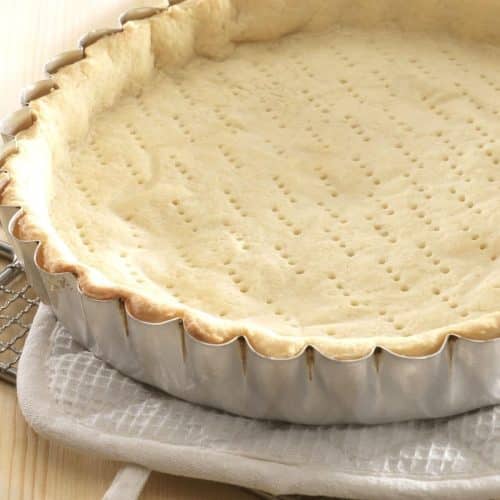
The Best Gluten-Free Pie Crust Recipe
Equipment
Ingredients
- 1 ½ cups gluten free flour blend * see note
- ¼ teaspoon salt
- 9 tablespoons unsalted butter * see note
- 1 large egg * see notes for egg-free
- 1 teaspoon lemon juice
- ¼ cup water +1 to 3 additional tablesppons
Email This Recipe To Me!
Instructions
- If you are making a top and bottom pie crust, note that you must double this pie crust recipe.
- Preheat the oven to 350º F. Make sure to set the oven rack to the middle of the oven.
- In a large mixing bowl, combine 1 1/2 cups gluten free flour blend and 1/4 teaspoon salt. Whisk to blend.
- Add the 9 tablespoons unsalted butter to the dry ingredients. Use a pastry blender to cut the butter into tiny pieces. If you don't have a pastry blender, freeze the butter and use a large grater to grate it into the flour.
- If you don't have a pastry blender, freeze the butter and use a cheese grater to shred the butter into the dry ingredients.
- In a small bowl, add 1 large egg, 1 teaspoon lemon juice, and 1/4 cup water
- Pour wet ingredients into the dry ingredients and mix. Mix gently with your hands or a large spoon until a dough forms. It should be firm but not sticky. Add more flour or water as needed. Wrap the pie dough in plastic wrap and chill the dough in the refrigerator for 15 minutes to cool the butter.
- Remove the pie dough from the fridge. Prepare your work surface by dusting a clean surface with flour or using a silicone mat. Shape the pie dough into a circle and add a second sheet of wax paper. If your dough is sticky, dust the silicone mat and the top of the dough with extra flour.
- Top with another piece of wax paper and use a rolling pin to roll flat in a circle shape. I rolled my dough to about 1/4 of an inch thick.
- Spray a 9-inch pie pan with gluten-free baking spray to prevent sticking. Note: PAM Baking Spray is NOT gluten-free! Remove the top layer of paper and gently flip the dough into a greased 9-inch pie pan. Peel away the silicone mat from the backside.
- Crimp the edges if you are not filling the crust now. To crimp the edges, hold your fingers in a V shape and place them on the outside of the crust. Use a finger to press the dough between your fingers so it crimps into the open space. Repeat this all the way around the edge of the pie crust.
Crust Instructions For No Top Crust:
- Add your pie filling and bake the pie at 350º F for 20-25 minutes.
- If you use a cream filling and do not need to bake the filling, poke a few holes in the bottom of the crust for air to vent.
- Cool the crust and add the cream filling.
How to Make the Top Crust:
- Add your pie filling to the crust. Roll out the top crust like you would for the bottom crust.
- Place the top crust carefully over the pie filling. Center the dough so it overlaps over the bottom crust.
- Follow the instructions above to crimp the top and bottom crusts together.
- Use a fork or sharp knife to cut 3-4 air holes in the top crust to vent the steam while the pie bakes.
How to Make a Lattice Top Crust:
- Roll the top crust dough flat, as you would for a regular pie crust top. Use a pizza wheel or sharp knife to cut out strips. You can make them as thick or thin as you like!
- Lay strips across the top of the pie in one direction. Take a dough strip, starting at one end, and weave it in and out of the strips already across the dough. Continue with each strip until you have a woven pie crust top.
- Cut strips out of the rolled top dough. Use the strips to weave a lattice-style crust.
Video
Notes
- I have tested this recipe with Cup4Cup, King Arthur Measure for Measure GF, Bob’s Red Mill 1 to 1 GF blend, and Authentic Foods Multi Blend. That does not mean others will not work; I just have not tested other flours. Note: Cup4Cup recently changed its flour blend formulation, and it does not behave exactly like the old formulation. I haven’t had a chance to retest this recipe with the new flour blend formulation.
- My homemade Gluten-Free All Purpose Flour works perfectly in this recipe.
- If your gluten free flour blend doesn’t contain Xanthan Gum or Guar Gum, please add 3/4 teaspoon.
- One reader used 3 TBSP of whipped aquafaba in place of the eggs to make it egg-free. She said it worked great.
- To make this recipe dairy-free, substitute the butter for vegan butter.
- These pie crusts will keep fresh for up to 4 days in an airtight container or for up to 4 months in the freezer.
SPECIAL NOTE
Please know that every gluten free flour blend has a different starch to grain ratio. If you use a blend I didn’t test, my rule of thumb is to add more flour if your dough or batter is wet and add more liquid if the dough or batter is too dry!
Nutrition
Nutrition Disclaimer
Nutritional information is an estimate provided to you as a courtesy. You should calculate the actual nutritional information with the products and brands you are using with your preferred nutritional calculator.
I truly hope you enjoy this recipe. I have been testing and creating gluten-free recipes for over 15 years. Creating gluten-free recipes that do not taste gluten-free is my goal for every recipe. Sometimes I only have to test a new recipe a couple of times, and others it takes multiple times. I do this so you get reliable, delicious results every time!


I made this recipe using 3 TBSP of whipped aquafaba as an egg substitute and it turned out FANTASTIC!!!!
I love this recipe but am allergic to eggs. Can I make it without the egg?
Hi Laureen, I haven’t tested this recipe with an egg replacer. If you do try it, please come back and let us know how it turned out.
I just made this recipe with 3 TBSP Aquafaba, whipped, as an egg replacer and it worked out great!
Thank you so much for coming back to let me know. This will help so many readers.
Sooo, do not recommend using gf bisquick for this. Top fluted part melted and literally fell into the bottom of the oven and scorched. Filling then spilled over the edges where the crust had broken and proceeded to make a waterfall of pumpkin. Looks like something the dog did after eating out of the trash. I did this as an experiment and like a good scientist, well not call it a fail. We’ll call it one more way NOT to make gf pie.😁
Hi Teresa, I agree. I am not a fan of gf Bisquick. It is very gritty and just hasn’t worked well in my recipes. I love to experiment as well…and I am so glad you wrote to prevent others from trying that blend.
Can you use a food processor to mix the dough?
Hi Teri, I do not advise using a food processor. It will break up the butter too much and you won’t get the flaky layers.
So I had to go to 3 stores to find a pastry cutter but it was worth it. I made a Dutch Apple Pie using this crust and my gluten-free granddaughters loved it. Thanks for the recipe!
Oh my gosh, I am so sorry for the extra trips. It really does cut in butter nicely. I would say next time freeze the butter and use a cheese grater. I feel like the flaky layers are bigger with the pastry blender, but a grater works in a pinch.
I am looking forward to making this pie crust. My one question is, do I have to use the baking spray. I do not bake often enough to purchase it.
Hi Nancy, If you feel more comfortable not spraying your pie pan, it should be okay given the amount of butter in the crust.
Can you mix the dough in a food processor?
Hi Teri, I find a food processor overmixes the butter and you don’t get as many flaky layers. If you don’t have a pastry blender, freeze the butter and use a cheese grater to shred it into the flour mixture.
Don’t know what happened., but the fluted crust turned out hard as a rock.
Hi Ada, I am sorry that happened and it isn’t the norm for this recipe. Please let me know what flour blend you used, and whether you used a pastry blender or cheese grater to shred your butter. Also how much you worked the dough, and if you swapped any ingredients. I am happy to troubleshoot because this is an awesome pie crust recipe.
Sandi, thank you so much! I finally purchased Bob’s Red Mill flour and made this pie crust for my pot pies. It was perfect and not difficult to make. You can’t tell it’s gluten free. Now my husband wants an apple pie. 😊
You have an avid fan forever.
Thank you so much, Debbie. I am so glad you love my pie crust recipe. Sounds like you have an apple pie in your future to keep your hubby happy 🙂
You stated that Pam Cooking Spray is not gluten free. According to the Conagra website, Pam Olive Oil, Pam Original, and Pam Butter are all gluten free. Pam for baking is NOT gluten free, it contains wheat flour.
Hi Mary, I am reading the post and it clearly states PAM Baking spray. There is nowhere that says Pam Cooking Spray in my post or recipe.
Do I have to par bake the crust if I’m making a pumpkin pie?
Hi Marion, you do not need to par bake this crust. Enjoy 🙂
Question-
Can I substitute something else for the egg – trying for a gluten free vegan version?
Hi Shawna, I haven’t tested an egg-free version of this crust recipe. If you do try it, I would love if you could come back and let us know how it turned out.
BEST GF Pie crust ever. Thank you for working so hard to figure this out for all of us. I definitely will be using this recipe again
I am so glad you loved this pie crust recipe. Thank you so much, Michele!
I’m not sure how old this post is, but I just found it. I have never made a piecrust from scratch in my life and I’m 53. But we have some gluten sensitivities in my home and I thought I would give it a try. I have been buying store-bought gluten-free piecrust. I cannot believe how simple and easy this recipe was and how incredibly delicious this piecrust tasted. I really didn’t expect it to taste good, but it was fantastic and I think I may have given up on store-bought pie crust forever.
Hi Amy, This post was originally written, tested, and put on my blog in 2017. I have updated it a few times, as I test other flour blends, etc. I am so glad you took a chance on my recipe, and that you loved how your pie crust turned out. Thank you so much!
Doing this many years ago. This is the best pie crust recipe. I do it with Caputo Fioreglut and it is so easy to roll out or cut shapes with cookie cutters. Excellent!
I am so glad this blend works for you, and works in my recipe.
This is my go-to crust for pies and handpies. The tip about extra cold butter grated in really makes a big difference. I used to use Bob’s 1:1 and it worked well, but have switched to the new Cup4Cup because I like it better overall and it worked just fine.
I am so glad you love this pie crust. I really appreciate your coming back to let me know! Thank you.
This is a great recipe! I used Cup4Cup flour, and it worked really well. I did have to add some additional flour so it wasn’t sticky. Just sprinkled a little at a time and it came together nicely. Thank you for the recipe and the notes included with the instructions. I’ll be using this pie crust recipe going forward!
Hi Debbie, Thank you so much for your kind words. I am curious whether you used the new Cup4Cup formulation free of the top 9 allergen free version or the older version with dried milk powder? I haven’t had much time to test the new blend.
Hi Sandy. I believe it was the new blend. I no longer have the bag it came in so I can’t check. Thanks again! Debbie
Thank you!
Sandy, I want to make 2 individual chicken pot pies so I need to double the recipe, right? Do I bake the bottom crust for the 10 minutes before filling with the chicken filling and top crust? Thanks?
Hi Carol, My pie crust recipe makes one crust, the bottom. Double it for a top crust to make a full pie. If you are making small, individual sized pies, I think doubling the one crust recipe should be perfect. I do not pre-bake the crust when making chicken pot pie. I hope this helps.
Can you make a double crust pie with this recipe?
Thanks,
Susie
Hi Susie, I always double this crust because I prefer to have a top crust. This crust makes the bottom so doubling it gives you the dough to add the top.
I made this recipe today for butter tarts, and you couldn’t tell the difference between this recipe and a regular wheat based recipe.
They turned out absolutely gr
eat.
Thank you Sandi. 🤗
You made my day. I am so glad you loved this recipe, Louise. Thank you!
Hi, can you use this recipe for tarts? I would be baking them in a muffin tin. The filling will be wet. Would the baking time change? Thank you!
Yes!! This recipe also works for tarts and pop tarts!
This is my go-to pie crust recipe. It comes out flakey and yummy every time! Thanks for another winning gf recipe!!
Thank you so much. I am so glad you love using my pie crust recipe!
Can this pastry be made using a food processer?
Hi Barbara, I haven’t tested this. It should be okay, but I would recommend using frozen butter so it doesn’t get heated up in the food processor.
I’m gonna try this again sometime just based on the positive reviews, but this was a disaster for me. it all ended up in the trash. I used very cold butter, and followed the recipe, but it turned into a sticky mess. I tried adding more flour but there was no saving it, I couldn’t even work with it cause it was so stuck to everything. I guess a lot less water next time, I don’t know other than that. I used bobs redmill 1:1 gf baking flour. I’ve always done well with that flour
Hi Erin, That is is interesting. I have had great luck with that flour blend. Do you store your flour in the refrigerator or freezer? Given your first result, I would advise using a little less water (1/4 cup) and adding more as needed.
I saw your review and was just wondering if you thought to make sure your water was really ice cold to avoid melting the butter pieces, besides possibly the amount you used? I know it was a while ago, but, Good luck .
I baked it too long and it was tough…. I was going by looks instead of time…. My error
No worries, please reach out via my contact page or email if you have further issues. How thick did you roll the crust and how long did you bake it for?
Do you need to pre bake and if so when? Some comments say yes for about 5 minutes and others say no. I’m taking about apple, blackberry or pumpkin.
Hi Dawn, it really depends on how wet the filling is…a basic blueberry pie, you should be fine not pre-baking it. I would pre-bake for 5 minutes for quiche.
My husband and I are both gluten-free. This is by far the best pie crust that we have ever had. It is so light and flaky. It’s also a nice buttery Rich flavor. This will definitely be my go to from now on.
Thank you so much. I am so glad you love this crust!
Do you need to par bake the crust with dried beans first before you add filling? I would be using this for a savory quiche.
Hi Jenna,
Par baking for about 5 minutes for quiche is optional. If ind this crust bakes very well without par baking. The edges tend to overbake with par baking. If you do, you would want to cover the edges with foil midway through baking.
This is by far the best gluten free crust I’ve ever made. Actually, it’s the best I’ve ever made period-gluten and gluten free! There are 5 of us with Celiacs in my immediate family, and all of us agree-the best pie crust on the planet!! The non gf members of my family also agree-the best ever. I made a carmel apple pie and it was fantastic!!
Thank you Sally!
Wow, that is an incredible compliment. I love the non gf family members loved the recipe too! Thank you!
Hi Sandi!
I am a novice baker and do not have a pastry blender. Is there something else I can use for the butter? I have a high powered blender and a small food processor?? Is dicing the butter by hand out of the question?
Hi Tiffany, freeze the butter and use a cheese grater to shred the cold butter into the dry ingredients. I would mix the shreds in intervals instead of all at once.
I will try this recipe. Why the lemon juice?
I think the acid helps with the flaky layers. I have always included a tiny bit because it works for my recipe nicely.
Making strawberry pie. How long do I bake if filling doesnt go in oven?
Hi Janet, I have never used a no-bake filling, but I would say bake it 18-25 minutes. The time will really vary by the thickness of the dough and the size of your pan, as well as the material your pie pan is made with. Glass cooks slower than metal, etc.
I was going to make a pumpkin pie but when I saw you have to bake the crust first., I wasn’t sure because pumpkin pie bakes for longer time..I’ve never seen that in any other recipe before..made your pumpkin snickerdoodle cookies….but I couldn’t put it in my hand cause was too soft., so I just used a spoon and dropped it on the baking pan and they turned out great..think easier way I did it..we’re soft and very good..please let me know bout pie crust..what if you don’t bake first., will it still turn out..thank you.
Hi Ada, What gluten free flour blend are you using? If your batter is too soft, and it was chilled, you need to add more flour. Every blend has a different grain-to-starch ratio and this affects the moisture levels. As for the pie, you are flash baking it to set the bottom. You don’t fully bake the crust first. I believe 8-10 minutes should suffice, depending on how thick the crust is and the size of your pan.
Can I use crisco in place of butter?
Hi Kathy, I have personally not tried Crisco, but I do have readers who have used it successfully.
Can the gluten free apple pie be made then frozen or refrigerated prior to baking?
Hi Ann, I haven’t frozen my pie before, but I have refrigerated it the day before baking it.
i am making a pumpkin pie and did not prebake the crust. using one 4 one flour. is it going to come out ok?
I typically don’t pre-bake my crust for pumpkin, you will be fine. I pre-bake the crust if I am using a cream filling that doesn’t get baked.
I’m making this tonight! Can you please tell me if I should prebake the crust before adding the filling for the quiche which usually bakes for 35-40min?
Hi Julie, I usually pre-bake it for 5 or so minutes. It doesn’t need much. Do keep an eye on it as it cooks with the filling and add foil around the crust if needed to prevent it from overcooking.
Bob’s Red Mill One-to-One GF Baking Flour worked well in this recipe, and also made it quick and easy to make. The result was a flaky crust that my husband and I gave 2 thumbs up! I cut the recipe in half in order to give it a test run, using a small mixer/food processor to blend the butter into the flour making sure I did not over process the dough. Then, I moved the mixture to a larger bowl to add the wet ingredients and shape the ball. The dough came together nicely. After baking, I sprinkled cinnamon sugar on the crust and enjoyed. Next time I make your wonderful crust recipe, I’ll be making a pie or a quiche. Thanks for the super easy and tasty recipe.
I am so glad you loved this crust recipe. Thank you so much for coming back to let me know, Jeanette.
Love all your recipes and am grateful I found you. When you suggest using vegan butter to make this dairy free it would be good to note Cup4Cup contains milk powder. Thanks so much for your generosity in sharing your talents 🙏🏻🙏🏻🙏🏻
Thank you, that is a good point. Thank you.
Hi!
Can you use any kind of filling in the pie crust? (lemon, blueberry, peach, strawberry, apples, etc.). Does the filling has to be cool or can it be warm?
Thank you!
I have a ton of great pie recipes on my blog using this crust! Here is the blueberry: https://www.fearlessdining.com/gluten-free-blueberry-pie-recipe/
I am making a rice pie which has to bake for 60 minutes… should I still partially prebake the crust?
Hi MJ, I am not sure what rice pie is. How wet is the filling?
My family really liked this pastry. I will definitely use it again. i used bob’s Red Mill 1:1 flour. thank you for the recipe
I am so glad everyone loved this pie crust. With Bob’s 1:1, you may want to let the dough sit for 15 min in the fridge so the rice flour can soften more.
Can egg replacer be used in this recipe? Perhaps Bob Red Mills or Flax seed Meal with water?
Hi Maggie, I haven’t tested an egg replacer in this recipe.
Hi, haven’t baked this yet, but I was wondering where you got the pie pan in the primary picture for the recipe?
Hi Jean, I found it on Amazon. It is actually a higher-sided tart pan. I don’t see the one I ordered on Amazon in stock, but this is pretty much the same. https://amzn.to/41aTtoS (affil link.)
I love this crust and my family does too! This is the first time I ever use egg in a pie crust. I was very skeptical but we loved it. I was able to make this into a double crust with out changing the recipe for a single crust. I like thin crust and it was perfect and flaky. I used Bob Red mills 1 to 1.
I am so glad you loved the recipe, Diana. Thank you so much!
Best I’ve tried so far since 2013
I am so glad you enjoyed my pie crust recipe. Thank you so much.
Could you provide a weight for the butter? Much more accurate than the tablespoon methods. Thanks
It should be roughly 128 grams according to a converter I found online.
I made your pie crust for my grandson on Thanksgiving. Everybody loved it & it doesnt taste gluten free. Seriously.
Thank you so much, Pam. I love that nobody could tell it was gluten free!
If I am making an apple pie with a top and bottom crust, do I need to bake the bottom crust first?
Thanks for sharing your recipes, we have been enjoying them 🙂
Hi, If you are making apple pie, You want to double this recipe for the top and bottom crust. You do NOT need to prebake the crust.
You say to ale the pie crust for 10 min., so if I’m making a pumpkin pie..it takes an additional 45 mins..will this over bake the pie crust..thank you
Hi Ada, I recommend baking the pie crust, but that is for a cream type of filling. If you are baking a pumpkin pie, add the pumpkin mixture to the unbaked crust and bake it all together.
Can I use lard in place of the butter?
Hi Stephanie, I haven’t tested lard. In theory, it should work as long as it is cold so that it can be cut into the flour. Please come back and let me know how it turns out.
Absolutely THE BEST crust I’ve made and so easy! I used Bobs Red Mill for mine. Fantastic!
I am so glad you love this crust! Thank you for coming back to let everyone know!
can you sub crisco vegetable shortening for the butter? I need it to be dairy free!
Hi Bethany, Crisco should be fine to substitute. I haven’t used it myself, but I think the melting point is similar. Please let me know how it turns out.
Hi Sandy – what a refreshing sight to see a great gluten free site and using the GF flour I’ve been using – KA Measure for Meausre. Question, want to make this pie crust for a 9″ deep pumpkin pie, above you say greased pie plate. I’ve never greased a pie plate – am I reading correctly? THanks-
Hi Mia, It is one of my favorite flour blends. I spray my pie dish with coconut oil. If you don’t have sticking issues with your pie plate, it should be fine as there is a lot of butter in the crust. Have a great Thanksgiving.
Needing to make this pie vegan. Do l use unsalted plant based butter? Thank you
Hi Tammy, I would definitely use unsalted vegan butter. Otherwise, the crust will turn out too salty. Have a great holiday!
Do you have to use an egg? I have a severe aversion to eggs and I cannot stand the taste/smell of eggs. Is the egg necessary for binding, my regular pie crust recipe does not call for egg.
Hi Cynthia, I have never made my crust without egg, but I would think an egg replacer like Bob’s Red Mill Egg Replacer would work well instead of egg.
Sandi
I love all your recipes and hints for successful gf baking. Thank you.
You are very welcome 🙂
I must have done something wrong. The crust stuck to the wax paper. I had to scrape it off and pat it into my pie dish. Baking now so I don’t know if it will be edible.
Hi Robin, I am sorry to hear the crust stuck to the wax paper. My guess is it could be the gluten free flour blend you used…it sounds like the dough was too wet. Next time if it seems sticky, dust with more gluten free flour…also adding some flour to the wax paper is a great way to avoid this too.
If I am using a top crust do I double the recipe?
Hi Holly, you will need to double the recipe for a top crust. Enjoy 🙂
How long do you bake an empty crust to fill with a cold, unbaked filling afterwards? Thank you!!!
Hi Nancy, I would bake it for 10-15 minutes and check it to see if it needs more time.
Hi there,
I want to make butter tarts, do you think I should pre-bake shells?
thanks so much for this recipe it’s amazing! I’ve tried numerous times to make a pie pastry that’s gluten free but always fell apart.
Thank you!!
Hi Laura, I would say to bake the crust for 10 minutes, then add the filling. Please do let me know how this turns out.
Yeah a gluten free version!!!! It looks flakey by the photos.What flour blend did you use. I often stear away from recipes that don’t give a specific flour blend or brand since there are so many out there that are comprised of different gf flours that change the successful outcome of the posted recipe. thanks
Hi Wanda, I have made this recipe with three different gluten free flour blends. Bob’s Red Mill 1 to 1 GF Blend, King Arther, and Authentic Foods Multiblend…they all worked great.
Thank you for the great recipe! I am making this crust tonight. Will it be okay if I leave it in the fridge until tomorrow and then add the pumpkin pie filling?
Hi Gabrielle, I haven’t tried this and I am curious what will happen. My thought is that it should work. I would love if you could come back and let us know if it worked.
Does this require xanthan gum and if so, how much should I add? Thanks!
Hi Kelly. If your gluten free flour blend does not contain xanthan gum or gust gum, please add 1 teaspoon. Have a great holiday!!
Did you use salted or unsalted butter?
Hi Mandi, I used unsalted butter but either will work 🙂